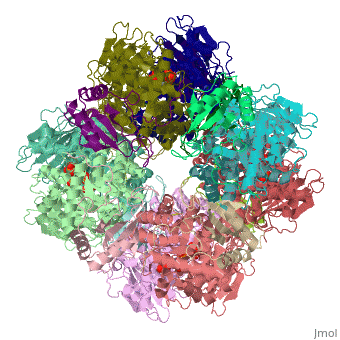Carbon Fixation
From Proteopedia
(Difference between revisions)
(New page: <StructureSection load='1rcx' size='350' side='right' caption='Spinach RuBisCO 8 large and 8 small chains complex with substrate ribulose-1,5- bisphosphate, 1rcx'> This is a default te...) |
|||
| Line 1: | Line 1: | ||
<StructureSection load='1rcx' size='350' side='right' caption='Spinach RuBisCO 8 large and 8 small chains complex with substrate ribulose-1,5- bisphosphate, [[1rcx]]'> | <StructureSection load='1rcx' size='350' side='right' caption='Spinach RuBisCO 8 large and 8 small chains complex with substrate ribulose-1,5- bisphosphate, [[1rcx]]'> | ||
| - | + | Biological carbon fixation or сarbon assimilation is the process by which inorganic carbon (particularly in the form of carbon dioxide) is converted to organic compounds by living organisms. See also [https://en.wikipedia.org/wiki/Biological_carbon_fixation]. | |
| - | + | ||
| - | + | Organisms that grow by fixing carbon are called autotrophs, which include photoautotrophs (which use sunlight), and lithoautotrophs (which use inorganic oxidation). | |
| - | + | ||
| - | + | ||
| - | + | ||
| - | + | ||
| - | + | ||
| - | + | ||
| - | + | ||
| - | + | ||
| + | Seven autotrophic carbon fixation pathways are known. | ||
</StructureSection> | </StructureSection> | ||
== References == | == References == | ||
<references/> | <references/> | ||
Revision as of 09:26, 19 December 2022
| |||||||||||

